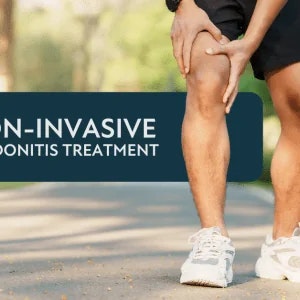Tendonitis, a widespread issue, causes discomfort and hinders daily activities. It has traditionally been treated with invasive procedures or prolonged rest periods. However, the landscape is changing, offering hope through conservative treatment alternatives. In this post, we’ll explore a range of non-invasive tendonitis treatments, from innovative technologies to holistic practices.
What is Tendonitis?
Tendonitis, also known as tendinitis, occurs when inflammation or irritation affects a tendon, the thick fibrous cord attaching muscle to bone. It commonly occurs due to overuse, repetitive motions, injury, or aging. This leads to symptoms such as pain, stiffness, swelling, and tenderness in the affected area.
Tendonitis can occur in various parts of the body. This includes the shoulders, elbows, wrists, hips, knees, and ankles. Activities such as sports, manual labor, or repetitive tasks often cause tendonitis, though underlying health conditions or biomechanical factors can also lead to its development. Treatment typically requires rest, ice, physical therapy, anti-inflammatory medications, and sometimes corticosteroid injections or surgery.
Non-Invasive Tendonitis Treatment Options
Let’s explore a few treatment options for tendon pain. These options are designed to alleviate discomfort and promote healing without resorting to invasive measures. From cutting-edge technologies to time-honored holistic therapies, we explore options. These are tailored to suit varying needs and preferences.
RICE Treatment
The RICE treatment method—Rest, Ice, Compression, and Elevation—serves as a cornerstone of home treatments. It is effective in reducing inflammation, alleviating pain, and promoting healing.
Rest helps the affected area recover by minimizing further strain and irritation. When you apply ice, it constricts blood vessels, reduces swelling, and numbs the area to alleviate pain. Using a bandage or wrap for compression controls inflammation and supports the injured tendon, promoting stability and reducing swelling. Elevating, especially for extremity injuries, reduces swelling by allowing excess fluid to drain away from the injured area.
Physical Therapy
Physical therapy is a vital component in treating tendonitis. It addresses pain relief, mobility restoration, and strengthening of the affected tendon and surrounding muscles. Initially, physical therapists use modalities like ultrasound, electrical stimulation, or heat and cold therapy to reduce inflammation and discomfort. They prescribe tailored exercises to enhance flexibility, range of motion, and tendon strength. Stretching routines are employed to improve flexibility and reduce stiffness. Strengthening exercises aim to stabilize the tendon and surrounding muscles.
Shockwave Therapy
Shockwave therapy is a non-invasive treatment for tendonitis. It utilizes acoustic waves to stimulate the body’s natural healing processes. By increasing blood flow, reducing inflammation, and promoting tissue regeneration, shockwave therapy helps alleviate pain and improve mobility in affected tendons. Typically administered in multiple sessions, this therapy is well-tolerated. It can be beneficial for chronic tendonitis cases that haven’t responded to other treatments.
Platelet-Rich Plasma (PRP) Injections
Platelet-rich plasma (PRP) injections involve concentrating platelets and growth factors from the patient’s blood. They are injected into the affected area or injured tendon to promote tissue repair. This also reduces inflammation associated with tendonitis. Doctors often recommend this minimally invasive treatment for chronic cases unresponsive to conventional therapies. While generally safe, its effectiveness and long-term relief vary among individuals. Multiple injections may be necessary.
Corticosteroid Injections
Corticosteroid injections are a common treatment for tendonitis. They deliver anti-inflammatory medication directly to the affected area to reduce pain and swelling. Although they provide rapid relief, corticosteroid injections typically yield temporary results and can cause side effects like temporary pain and tendon weakening. Patients should consider their use carefully alongside other treatments as part of a comprehensive management plan.
Conclusion
In conclusion, non-invasive treatment options offer promising avenues for managing tendonitis. They empower individuals to find relief and regain mobility without the need for invasive procedures or prolonged downtime. From physical therapy and shockwave therapy to platelet-rich plasma (PRP) injections and corticosteroid injections, a variety of approaches cater to diverse needs and preferences.
If you’re struggling with tendonitis and seeking effective, compassionate care, look no further than CLS Health. Our dedicated providers specialize in non-invasive treatment modalities. They offer personalized care tailored to your specific condition and goals. Don’t let tendonitis hold you back any longer. Schedule an appointment today and take the first step toward a pain-free, active lifestyle.





